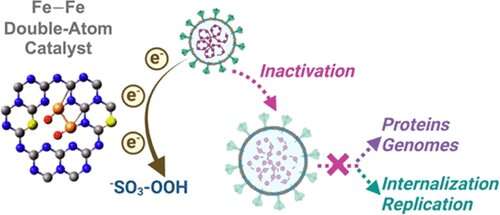This article has been reviewed according to Science X's editorial process and policies. Editors have highlighted the following attributes while ensuring the content's credibility:
fact-checked
peer-reviewed publication
trusted source
proofread
Nanomaterial boosts potency of coronavirus disinfectants

The use of peroxide-based disinfectants has grown with the emergence of the COVID-19 pandemic. Yet, the extensive use of chemical disinfectants to kill viruses and other pathogens can also threaten human health and ecosystems.
Now, a research team led by the George Washington University has engineered a new nanomaterial that can boost the potency of common disinfectants. The team showed that when the nanomaterial—a double-atom catalyst—is mixed with a peroxide-based disinfectant, the disinfectant is two-to-four times more effective in disabling a coronavirus strain compared to when the disinfectant is used alone.
The ability to enhance disinfectants with nanomaterials engineered from earth-abundant elements like iron and carbon is more sustainable and cost-effective, say the researchers.
"Peroxides are often used to kill pathogens but we have to use a much higher concentration of them than we really need," Danmeng Shuai, senior author and associate professor of civil and environmental engineering at GW, said. "With this nanomaterial, we can actually reduce the amount of peroxides we're using daily, which not only reduces costs but also offers a more sustainable method of disinfection while still achieving the best performance for killing environmental pathogens."
Shuai and the team, which included David P. Durkin from the United States Naval Academy and Hanning Chen from the University of Texas at Austin, developed a Fe−Fe double-atom catalyst, which they mixed with a peroxide and coronavirus strain in two different mediums: artificial saliva and freshwater drawn from a local river to mimic contact surface cleaning and water disinfection, respectively.
The researchers observed that the nanomaterial worked by shuttling electrons from the virus to the peroxide. As a result, the virus became oxidized, damaging the viral genome and proteins as well as the coronavirus lifecycle in the host cells.
"Our work paves a new avenue of leveraging advanced materials for improving disinfection, sanitation, and hygiene practices," said Zhe Zhou, first author on the paper and a Ph.D. candidate at GW. "Our discovery also has broad engineering applications for advancing catalysis in pollution control, enabling effective and safe disinfection, controlling the environmental transmission of pathogens, and ultimately protecting public health."
The nanomaterial could be scaled to deactivate environmental pathogens in diverse environments, the study's researchers said. Examples include water purification—potentially packing the nanomaterial in columns and allowing water to pass through, purifying the water in the process. It can also be scaled to use in spray form to disinfect contact surfaces, like countertops.
The researchers said future studies should focus on optimizing the materials to further advance the disinfection potency to achieve eco-friendly and robust disinfection to further protect public health.
The findings are published in the journal Environmental Science & Technology.
More information: Zhe Zhou et al, Fe–Fe Double-Atom Catalysts for Murine Coronavirus Disinfection: Nonradical Activation of Peroxides and Mechanisms of Virus Inactivation, Environmental Science & Technology (2023). DOI: 10.1021/acs.est.3c00163
Journal information: Environmental Science & Technology
Provided by George Washington University





















